Recent Water Damage Posts
The Silent Threat: How Water Leaks Impact Businesses and What You Can Do About It
3/5/2024 (Permalink)
Water leaks are often overlooked, yet they pose a significant risk to businesses of all sizes. In fact, water leaks are the most common form of loss reported by businesses, and their consequences can be far-reaching. Let's explore the effects of water leaks on businesses and how SERVPRO of Puyallup/Sumner can help mitigate the damage and minimize downtime.
Water leaks can cause extensive damage to property, including structural damage to buildings, flooring, walls, and equipment. The presence of water can lead to mold growth, compromising indoor air quality and posing health risks to employees and customers alike.
The cost of water damage can be substantial, encompassing repair and restoration expenses, as well as potential fines for non-compliance with building codes and regulations. Additionally, insurance premiums may increase following a water damage claim, further adding to the financial burden on businesses.
Perhaps the most significant impact of water leaks on businesses is the disruption to operations and business downtime. Water damage can force businesses to close temporarily, resulting in lost productivity, missed deadlines, and dissatisfied customers. The longer the downtime, the greater the potential loss in revenue and reputation damage.
At SERVPRO of Puyallup/Sumner, we understand the urgency of addressing water leaks promptly and effectively. Our team of highly trained professionals is equipped with advanced technology and expertise to handle water damage restoration quickly and efficiently. We offer 24/7 emergency response services to mitigate further damage and minimize business interruption.
In addition to water damage restoration, SERVPRO of Puyallup/Sumner provides comprehensive mold remediation services to address any mold growth resulting from water leaks. Our goal is not only to restore your property to its preloss condition but also to ensure a safe and healthy environment for your employees and customers.
With SERVPRO of Puyallup/Sumner by your side, you can rest assured that your business is in good hands. Don't let water leaks jeopardize your business's success—contact us today for fast, reliable, and professional water damage restoration services.
Remember, when it comes to water damage, swift action is crucial. Trust SERVPRO of Puyallup/Sumner to handle the aftermath of water leaks and minimize downtime for your business.
The Crucial Role of Maintenance in Preventing Winter Water Damage
12/1/2023 (Permalink)
As the cold, rainy months approach, it's essential to take proactive measures to safeguard your home and business from potential water damage. Neglecting maintenance during this season can lead to a host of issues, including leaks, flooding, and mold growth. In this blog post, we'll explore the importance of regular upkeep and offer tips on preventing water damage.
- Gutters & Downspout Maintenance –
Clogged gutters and downspouts can lead to water overflow, causing damage to your roof, siding, and foundation. Regularly clean gutters to ensure proper drainage and consider installing gutter guards to prevent debris buildup.
- Roof Inspection –
A well-maintained roof is your first line of defense against water intrusion. Check for missing or damaged shingles, and promptly address any issues to prevent leaks. Consider hiring a professional for a comprehensive roof inspection before the rainy season.
- Seal Windows & Doors –
Inspect the seals around windows and doors for gaps or cracks that could allow water infiltration. Use weather-stripping or caulk to seal any openings and keep the cold and wet weather outside.
- Check for Leaks Indoors –
Inspect your plumbing, including faucets, pipes, and appliances, for any signs of leaks. A small drip can quickly escalate into a major problem, leading to water damage and potential mold growth. Address leaks promptly to avoid costly repairs.
- Maintain Landscaping –
Ensure that the grading around your home or business directs water away from the foundation. Poor drainage can lead to basement flooding and structural damage. Consider installing a French drain or extending downspouts to divert water away from the building.
- Inspect the Foundation –
Regularly inspect your home or business foundation for cracks or signs of water seepage. Seal any cracks with an appropriate sealant to prevent water from entering and causing structural damage.
- Sump Pump Maintenance –
If your property has a sump pump, make sure it is in good working condition. Test the pump regularly, and consider installing a battery backup system to ensure functionality during power outages.
- Winterizing Outdoor Plumping –
Prevent frozen pipes by disconnecting and draining outdoor hoses. If applicable, shut off exterior water valves, and insulate pipes in unheated areas, such as basements and crawl spaces.
Taking the time to perform routine maintenance can save you from the headaches and expenses associated with water damage during the cold, rainy months. If, despite your best efforts, you find yourself dealing with water damage, remember that SERVPRO of Puyallup / Sumner is available 24/7/365 for emergency water remediation services. Call us at (253) 848-0800, and let our team of experts help restore your home or business to its pre-damage condition. Stay dry and protected this winter!
A Comprehensive Guide to Hurricane Preparedness and Recovery
11/1/2023 (Permalink)
As the calendar flips to November, we find ourselves in the last month of hurricane season. it's crucial to remember that while the peak of hurricane activity may have passed, the potential for storms and their aftermath still lingers. This blog post will provide you with valuable information on how to stay safe during this time and what to do if you experience a hurricane or flooding.
Pre-Storm:
One of the most critical aspects of hurricane preparedness is staying informed. Keep an eye on weather forecasts, and if a hurricane or severe storm is expected, monitor updates from reliable sources such as the National Hurricane Center, your local government, and news outlets. Make sure to have a battery-powered weather radio on hand in case of power outages.
Create an Emergency Kit
Having an emergency kit ready can make a world of difference during a hurricane. Include essential items like non-perishable food, water, flashlights, batteries, a first-aid kit, personal hygiene products, and important documents. Don't forget to stock up on any necessary prescription medications and pet supplies if you have pets.
Prepare Your Home
Securing your home is vital to your safety during a hurricane. Reinforce windows and doors, trim tree branches that could become projectiles, and clear your gutters. If you live in a flood-prone area, consider investing in sandbags and flood barriers to protect your property.
Evacuation Plan
If you live in an evacuation zone, be prepared to leave when authorities issue evacuation orders. Have a plan in place for where you will go, and make arrangements for your pets if you have them. It's essential to leave early to avoid traffic congestion and ensure your safety.
Communication
Keep lines of communication open with your family and friends. Make sure everyone knows your whereabouts and how to reach you. Establish a central point of contact in case family members get separated during the evacuation.
Stay Safe During the Storm
During the hurricane, stay indoors and away from windows. If flooding occurs, move to higher ground, and never attempt to drive or walk through floodwaters. The power may go out, so use flashlights instead of candles to prevent fires. Charge your phones and have a portable charger ready to stay connected.
Post-Hurricane Actions:
After the hurricane passes, it's not time to let your guard down. Be cautious of downed power lines, flooding, and debris. Check on your loved ones, especially the elderly and those with special needs. If you evacuated, wait for authorities to declare it safe to return home.
Stay Informed
After the hurricane has passed, continue to stay informed about local conditions and updates. Keep your weather radio or other communication devices handy to receive updates on road closures, emergency services, and relief efforts. This information is invaluable as you assess the situation and plan your next steps.
Contact Loved Ones
Let your friends and family know that you're safe and sound. Keep your cell phone charged and use it to communicate with your loved ones. A simple text message can ease their worries and keep the lines of communication open.
Document the Damage
Take photographs and videos of the damage to your property, both inside and outside. This documentation can be vital when dealing with insurance claims and seeking assistance. Make sure to document any damage to vehicles as well.
Contact Your Insurance Company
Contact your insurance company as soon as possible to report the damage and start the claims process. Be prepared to provide them with the documentation you collected. If you're unsure about your policy's coverage, ask your insurance agent for clarification.
Assess Your Home's Safety
If you're allowed back into your home, assess its safety and the extent of the damage. Secure any openings to prevent further damage, such as covering broken windows and tarping damaged roofs. Take steps to remove water and begin drying out your home to prevent mold growth by calling SERVPRO of Puyallup / Sumner at (253) 848-0800.
Seek Assistance
If you're in need of immediate assistance, contact local emergency services or relief organizations. They can provide you with information on shelters, food distribution, and medical services. Local government agencies may also provide resources for disaster recovery.
Reach Out to FEMA
In the aftermath of a major disaster, the Federal Emergency Management Agency (FEMA) may offer assistance to affected individuals and communities. Contact FEMA to inquire about the available aid and how to apply for it if you or your family need it.
Begin Cleanup and Repairs
Once your safety is ensured, and you've taken the necessary steps to document and assess the damage, you can call SERVPRO of Puyallup / Sumner to begin cleaning up and essential repairs. Keep all receipts and records of expenses related to recovery efforts, as these may be important for insurance and assistance claims.
Experiencing a hurricane or flooding can be a challenging and emotional ordeal. However, by following these steps after the storm and calling SERVPRO of Puyallup / Sumner, you can begin the process of recovery and rebuilding. Remember to stay safe, document the damage, and seek assistance when needed. With the support of your community, the appropriate agencies, and SERVPRO, you can recover from the aftermath of a hurricane and look forward to better days ahead.
Water Heater Malfunction Noises
3/16/2023 (Permalink)
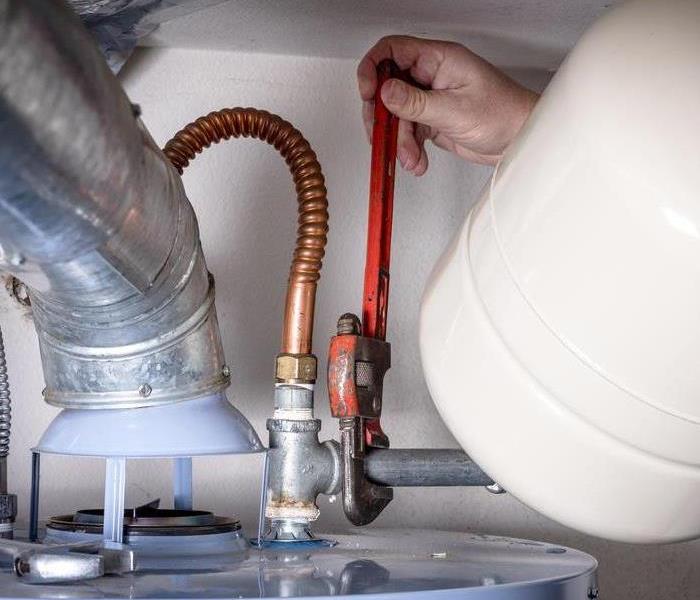 If your water heater is making unusual noises, call a professional.
If your water heater is making unusual noises, call a professional.
Water heaters are essential household appliances that help us keep our homes warm and comfortable. However, if you've noticed a strange noise coming from your water heater, it could be a sign of an issue that's causing problems for the appliance or even for your entire home. In this article we'll explain what these noises are, why they happen and how to get them fixed—fast!
Clanging noises.
If you hear clanging or banging noises coming from your water heater, it could be a sign of damage or failure. You should have a professional inspect your appliance as soon as possible to determine whether the problem is serious.
If the sound comes from inside the tank, it could mean that there's sediment build-up on internal parts and they're hitting each other when hot water flows through them. This may require professional cleaning or replacement of some parts--and if left untreated, could lead to more extensive damage down the road.
Creaking noises.
If you hear a creak or groan coming from your water heater, it could be a sign of a problem.
If your tank has been running for an extended period of time, it may need to be drained before refilling with fresh water and restarting the heating process. This can help prevent build-up in the tank and improve efficiency over time.
Knocking noises.
If your water heater is making knocking noises, that's usually a sign of sediment buildup. Sediment buildup can cause your water heater to malfunction and even leak, which can lead to expensive repairs or even damage to your home. In addition to these issues, sediment buildup may also cause the unit to fail prematurely.
Pulsating sounds.
Pulsating sounds are usually caused by a faulty expansion tank. This is a small device that sits on top of the water heater, filled with pressurized air. If it fails, it can cause your water heater to make noises that sound like pops or hisses.
If you hear this kind of noise coming from behind your wall or under your floorboards, get in touch with an expert immediately! Your home may not be safe if there's any sort of structural damage going on behind its walls. In addition to checking for structural issues (like cracks), they'll also look at whether or not the expansion tank needs replacing and whether replacing it will fix any other problems that might have caused this issue in the first place
Roaring water noises.
If your water heater is making a roaring sound, it could be caused by water hammer. Water hammer is a noise that happens when the water in your pipes moves too quickly and hits them with force. This can cause damage to both your pipes and appliances--and if you hear this sound coming from your hot water heater, it's time to call a plumber!
If your water heater is making unusual noises, it could be a sign of trouble. You should get in touch with a professional as soon as possible. SERVPRO is here to help 24/7 for your water restoration emergency if you have a water loss from a faulty water heater.
Signs of a leaking pipe in your home
2/9/2023 (Permalink)
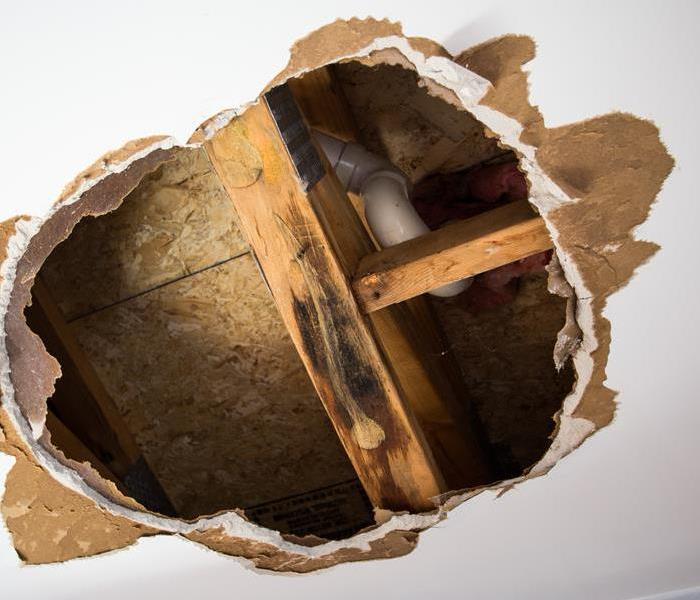 Signs of leaking pipes in your home? Give SERVPRO a call today!
Signs of leaking pipes in your home? Give SERVPRO a call today!
Leaking pipes are one of the most common home repair issues. If you suspect that you have a leaky pipe in your home, check for stains on your walls, ceilings or floors where moisture could build up over time and create damage.
Stains on the walls and ceilings
If you notice stains on the walls and ceilings of your home, it's possible that a pipe is leaking. The most common cause of such leaks is water seeping through the walls, but leaky pipes in the attic or basement can also cause these stains. These stains can be easy to see or hidden behind furniture or curtains.
A steady dripping sound
A steady drip or a gurgling sound can indicate a leak. If you hear the drip of water (or even better, see it!), there’s likely a problem with your pipes or faucets. Standing water is also an indication that you have a water leak somewhere close. Check corners or under sinks and appliances which could be a potential water damaged area from a refrigerator or washing machine. If you suspect that you have an issue with your pipes, call professionally licensed plumbers immediately to come take care of the problem before it gets worse.
Leaks under sinks or toilets
Leaking toilets, sinks, showers, and bathtubs can leave your bathroom with water damage. An unexplained spike in your water bill is the most common notice that you could potentially have a leaking pipe or pipe break in your home or business.
But how do you know if it’s just a leaky faucet or something bigger? The good news is, detecting a leak can be relatively simple: most leaks can be detected by following two steps: first, finding the source of the leak (i.e., where it’s occurring); and second, determining its extent (i.e., how much damage has been done).
Cost to Repair
Leaking pipes can lead to serious water damage which can be costly to repair. Leaks are also more likely to occur if your home has been built or renovated since the mid-1990s, when new piping materials and installation methods were introduced.
If you think you might have a leak, it’s important that you get into contact with a plumber as soon as possible after seeing signs that there could be one. The longer an issue goes undetected, the more damage will occur inside your home and the more expensive repairs will become. If you need help locating professionals who can help identify and fix leaks in your home or office building.
Your water bill is a good indicator of whether or not your home has a leak. If you see an increase in your water bill over the last few months and you’re not sure why, there could be a problem with your pipes. You may want to call an expert to help diagnose the problem.
Why Closing the Bedroom Door Matters to Prevent Fire Damage
12/1/2022 (Permalink)
 Fire is fast!
Fire is fast!
Why Closing the Bedroom Door Matters to Prevent Fire Damage
If you want to be better protected from fire, then it is important to close your bedroom door at night. This may seem like a strange recommendation, but it is one that has been endorsed by numerous fire departments across the country. Understanding why this is so vital can help you sleep more soundly at night and get out of your home quickly if there is ever a fire in it.
A closed bedroom door can help protect you from a fire.
If your home catches on fire, it's important that everyone gets out safely. A closed bedroom door can make this easier by slowing the spread of fire and smoke from the rest of your home. By giving people additional time to get out, closing doors can be a lifesaving step in an emergency like this one.
Bedroom doors can help slow the spread of fire and smoke throughout the rest of a home.
When it comes to fire damage, the door is a good friend. Doors can help slow the spread of fire and smoke from the rest of your house. This can provide you with a layer of protection between you and the flames. It also provides a barrier that helps contain fire damage in one room.
For doors to do their job as a barrier against heat, they need to meet certain requirements:
- The door should be constructed with professional grade materials
- It should have reinforced frames that can hold up against high temperatures
- It should be fitted with self-closing hinges, so that it stays closed when not in use
A closed bedroom door can give people additional time to get out of a burning home.
- Closing the door to your bedroom can give you up to 30 seconds of additional time.
- The room will be less smoky, which is especially important if you or anyone in the house has asthma or other respiratory problems.
- The closed door will help keep fire from spreading to the other rooms of your home. A closed bedroom door can prevent smoke and flames from entering other rooms, reducing damage by keeping them cool and making it easier for firefighters to put out any remaining fires in those areas of your home (or apartment).
Fire departments recommend that you sleep with your bedroom door closed.
It’s important to know that when you sleep with a closed door, you’re giving yourself more time to escape. In addition, if a fire occurs in the middle of the night, closing your bedroom door will reduce smoke inhalation and save your life.
For pets and children who can’t help but wander around at night, it’s important to keep them safe by keeping their doors closed. Leaving an open door allows them access to other areas of your home where they could get trapped or injured without any warning.
It is important to close your bedroom door at night to be better protected in case there is a house fire.
It's important to keep in mind that fires spread quickly, and closed doors can slow the spread of fire and smoke from one room to another.
Closing your bedroom door will give your family members an opportunity to get out of a burning home without being injured by flying embers or smoke inhalation. It also give firefighters and advantage by helping them get ahead of the progress of the fire.
As such, most fire departments recommend that you sleep with your bedroom door closed if possible—and it's an effective way for you or other members of your household to protect themselves.
I hope that this information will help you to understand the importance of keeping your bedroom door closed at night. I know it seems like a small thing, but if there is ever a fire in your Puyallup, WA home, it could mean the difference between safety and danger. Please keep this in mind as you go through each night and make sure all doors are shut before going to sleep!
Why does my toilet leak every time I flush?
11/9/2022 (Permalink)
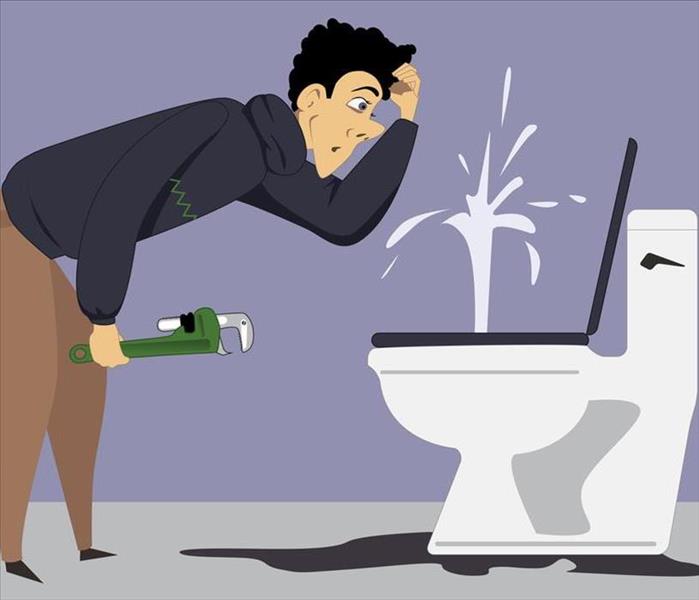 If you are experiencing a toilet leak and you can't fix it call a professional.
If you are experiencing a toilet leak and you can't fix it call a professional.
Why Does My Toilet Leak Every Time I Flush?
You can fix most toilet leaks yourself with a little elbow grease (and maybe some plumber's putty). In this post we'll discuss why toilets leak and how to tell if you have a leaky tank or bowl.
Toilets leak for a lot of reasons.
You’re not alone. Many people have experienced a toilet leak, and it can be difficult to determine why it happens. There are many reasons that a toilet might leak, including:
- A clogged drain line
- A loose flapper or flush handle
- A leaking shut off valve on the tank
- A cracked or broken tank
1. Dry wax ring or improper installation.
If your toilet leaks every time, you flush it, you may have a leaky wax ring.
The wax ring is a rubber or PVC device that fits between the toilet bowl and the floor to prevent leaks from occurring. When properly installed and maintained, it should last for about two years before needing replacement. Leakage can often occur once the wax ring ages and or due to improper installation.
2. Tank flange can be broken or tank not tightened.
If you've tried to diagnose the leak and determined it's coming from your tank, then the problem could be that:
- Your tank flange is broken or not tightened properly. This will allow water to run down into the bowl of your toilet. The flange is a metal piece that sits between the tank and bowl, giving you a tight seal against leaks.
- Your toilet isn't level, causing one side of your toilet to be higher than another (often due to uneven flooring). If this happens, water can run out of one side when flushed since there's no longer an airtight seal around the toilet base.
- Your support is broken or not installed properly and cannot withstand heavy usage without falling apart under repeated use or shifting over time.
3. A worn out, cracked or damaged flapper, which is the most common reason for a leaking toilet tank.
The most common reason for a leaking toilet is a worn-out, cracked, or damaged flapper. The flapper is the rubber seal that keeps the water in your tank and not on your floor. Replacing it yourself takes only a few minutes and costs less than $10 at hardware stores. If you don't feel comfortable doing that yourself, you can have a plumber replace it for about $50-$100.
4. A tilted or loose toilet bowl may cause water to slowly leak from the base of the toilet and pool in the bathroom floor around the toilet.
If your toilet is leaking, either water is coming out of the base of the toilet or there is a pool of water around it. In both cases, you should check to make sure that the bowl isn't tilted or loose.
If your floor is not level, this can cause your toilet bowl to become tilted. To fix this problem, adjust the bolts connecting your toilet to its base until they're barely touching each other.
If your floor has shifted or moved over time and no longer supports your toilet securely, it could be loose and therefore prone to leaking. In this case, unclamp from under any pedestals that support it and then gently lift on all four sides until it's level again before replacing any clamps or pedestals you removed in order for them not to get lost down there somewhere!
5. Condensation on a toilet tank is another possibility if you see droplets of water underneath or on your tank lid, along with damp walls and floors around your toilet.
If you're noticing condensation on your toilet tank, it's not always a sure sign that the leak is coming from inside the toilet. Condensation can be caused by several factors:
- A leaking roof or window AC unit outside of your bathroom
- A faulty humidifier in another room that's sending moisture into your walls and flooring
- An air-conditioner is running constantly and adding humidity to the air in your house.
6. A damaged shut-off valve causing a drip at the angle stop of your toilet supply line, where it’s attached to the angle stop (wall shut off) just below the tank, which generally means that you have a slow leak in your toilet supply line.
If none of the above suggestions have resolved your leak, it could be that there is a problem with the actual shut-off valve or supply line itself. The first step to finding this out is to check for leaks in each of these components:
- Shut off valve
- Angle stop (wall shut-off) just below tank
- Supply line from shut off valve to wall and/or floor drain connection. Check for kinks in lines, cracks in PVC pipes, and breaks in copper pipes.
The good news is that most of these problems can be fixed quickly and easily. All it takes is a little know-how, some time, and patience—and maybe even a sense of humor!
The Importance of Tending to Both Primary and Secondary Damage
7/15/2022 (Permalink)
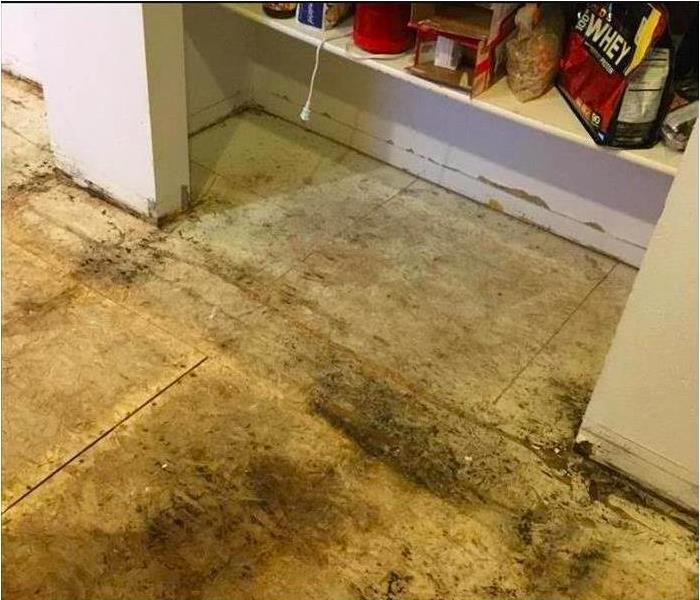 Water and mold damage in a South Hill, WA home
Water and mold damage in a South Hill, WA home
The Importance of Tending to Both Primary and Secondary Damage
Black mold is a fungus that thrives on dampness. When water penetrates something organic, it triggers the mold's development, permitting fast reproduction. Homeowners may concentrate on the mold but not think much about how it started. Both the source, though, and the result are significant. If one isn't fixed, then the other may just continue to reappear down the road; therefore, homeowners should be aware of the house's secondary and primary damage. When both are understood and cared for, the property can be properly restored.
What Is Primary Damage?
Something initiated the trouble, causing a level of high humidity or excess wetness. This is considered the primary cause. For example, any of the following would fall into the classification:
- Pipe burst
- Sewer backup
- Leaky faucet
- Missing shingles
A water restoration company in South Hill, WA, should investigate the premises, searching for the source. The experts then should shut off the water supply, fixing any plumbing issues. By taking this step first, the professionals mitigate the devastation.
What Is Secondary Home Damage?
Secondary complications stem from primary cause. A broken pipe, for example, allowed moisture to penetrate a space. When it soaked into the walls and flooring, the fluid started secondary concerns. Black mold, for example, might begin to grow. In addition, wood can rot, carpet can get contaminated and valuables are likely to become ruined.
The team tends to the secondary damage by extracting moisture, sanitizing the property and replacing spoiled items. Drenched dry wall and carpeting is pulled out. These porous materials are too difficult to fully clean. Instead, replacements are needed. Content cleaning can be applied to things that fall into the following categories:
- electronics
- pictures
- documentation
- fixtures
Speak with the crew about anything special. They can advise of the proper treatment.
Black mold isn't something you want in your home.
To keep it at bay, you'll want to be aware of primary water damage. With that under control, residents are less likely to suffer other headaches.
How To Repair Belongings After a Flood
4/5/2022 (Permalink)
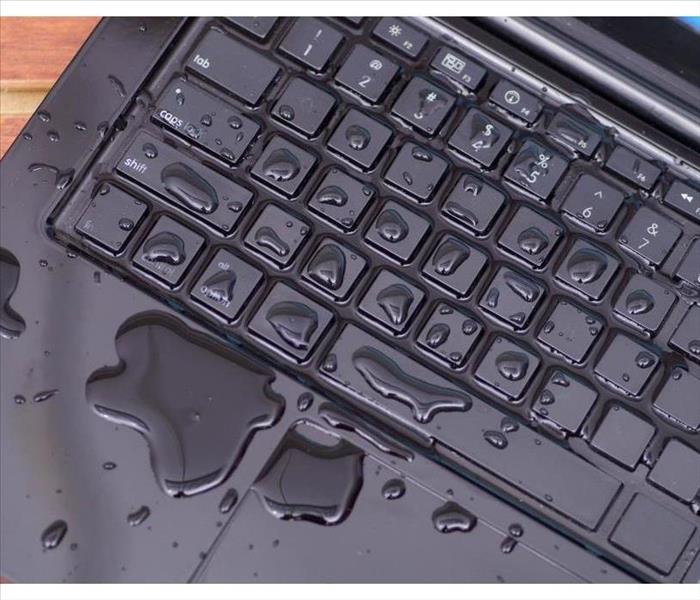 Before touching any electronics that have been in contact with water, make sure they are not plugged in to any outlets.
Before touching any electronics that have been in contact with water, make sure they are not plugged in to any outlets.
How To Repair Personal Effects After A Flood
When flooding occurs, it can damage your belongings. Whether the water in home is from a broken pipe, sewage backup, rain or another source, there are things you can do to repair your possessions.
Hire a Professional
A professional water damage restoration service can repair or replace many different types of items, including:
- Upholstered furniture
- Documents
- Photos
- Building materials
- Flooring
A water damage restoration service in Puyallup, WA, should also treat the area to prevent mold growth once the water has been removed.
Fabric
When fabric items, such as clothing or curtains, are damaged by water in home, it is best to take them to a dry cleaning service. They can help remove water stains, restoring your belongings to their original condition. Thicker fabrics, such as upholstery, may need to be treated by a professional restoration service.
Building Materials
Water can cause building materials, including drywall and wood, to deteriorate. After cleaning up flooding, check the area for signs of moisture or deterioration. If the flooding is from a broken pipe, make sure to thoroughly check the surrounding walls. Deteriorated building materials typically must be replaced.
Electronics
Before touching any electronics that have been in contact with water, make sure they are not plugged in to any outlets. If they are, turn off the power in the area first to avoid electrocution. Some electronics can be repaired by taking off battery covers and any other removable parts and allowing the water to drain out. It can also help to place devices such as laptops and mobile phones in a bowl of rice to absorb the moisture. If drying the item and replacing the batteries does not fix the device, an electronics repair shop may be able to help.
If water in home has damaged your belongings, you can fix them by hiring a professional or fixing items, such as fabric, building materials and electronics, at home.
Do You Know When To Flush Your Home’s Water Heating System?
1/13/2022 (Permalink)
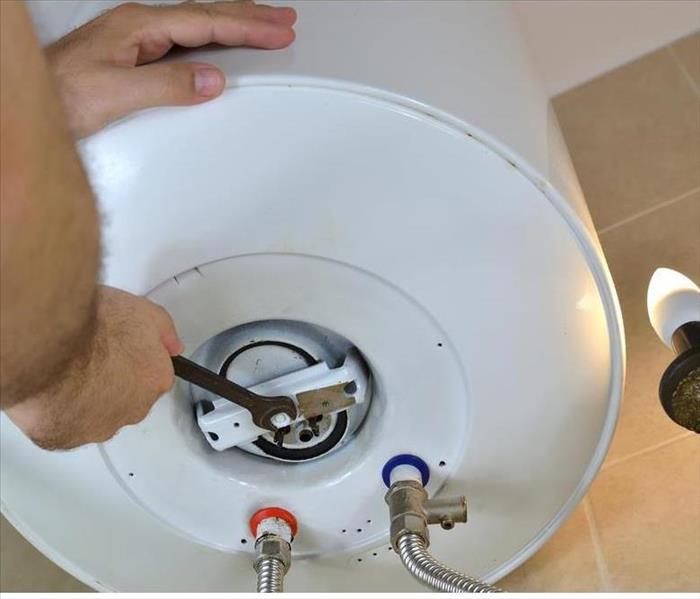 To keep your water heating system functioning properly, you must occasionally flush it.
To keep your water heating system functioning properly, you must occasionally flush it.
Do You Know When Your Home's Water Heating System Needs To Be Flushed?
Like most residents of Sumner, WA, you use hot water inside your home every day. After all, not only do you enjoy rinsing off in a soothing shower, but you also must keep dishes, clothing and other items clean. To keep your home’s water heating system in tip-top shape, you must occasionally flush your water heater.
Signs of Wear and Tear
When the water heating system in your home is functioning properly, you probably don’t think much about it. If there is a problem, though, the heater can be impossible to ignore. If you notice any of the following, your unit may need some work:
- Strange noises
- Leaks
- Rust
- Deposit buildup
- Failure to heat water
A Timetable for Flushing
To keep your water heating system functioning properly, you must occasionally flush it. While every system is different, you must think about usage to know when a water heater flush is appropriate. Use the following timetable as a general guideline:
- For households with one or two members, flush the system approximately once per year.
- For households with three to five members, flush the system approximately every eight months.
- For households with six or more members, flush the system approximately every six months.
Special Considerations
The above guidelines are effective for most homes in Sumner, WA. Occasionally, however, certain factors require homeowners to inspect and service water heating systems more frequently. If you use well water or have high levels of sedimentation in your water supply, you probably should inspect your home’s water heating system every two or three months to ensure you do not develop a water leak. If you do, you may need to contract with a reputable water restoration service to mitigate damage to your basement and other areas.
With a bit of work, you can decrease your chances of having a problem with your water heater. With regular inspections and flushing, you ensure your home’s water heating system remains in excellent shape.



 24/7 Emergency Service
24/7 Emergency Service






